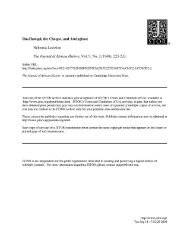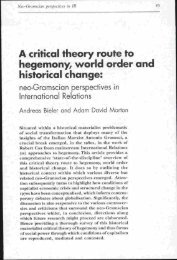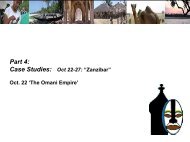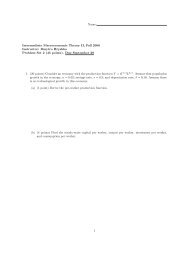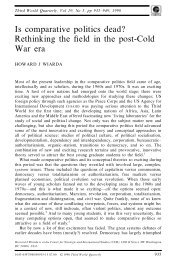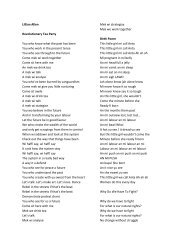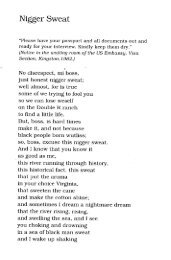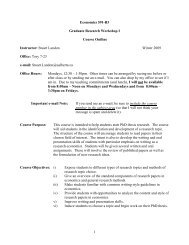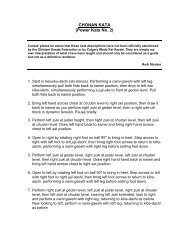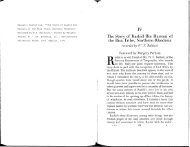personal memories revolutionary states and indian ocean migrations
personal memories revolutionary states and indian ocean migrations
personal memories revolutionary states and indian ocean migrations
You also want an ePaper? Increase the reach of your titles
YUMPU automatically turns print PDFs into web optimized ePapers that Google loves.
involved <strong>and</strong> the view that “Islam itself” can explain all. We need to ask different<br />
questions or we will never find new answers. A rethinking of the “unconscious<br />
process” by which some of Trimingham’s “agents” reproduced Swahili culture,<br />
including Islam, is precisely what I am trying to do here. I am questioning the<br />
familiar, as Foucault prescribes, in order to reveal the not so “unconscious” aspects<br />
of that process.<br />
When I began my research for this work, I encountered Abdul Hamid M.<br />
el-Zein’s, The Sacred Meadows: A Structural Analysis of Religious Symbolism in an East<br />
African Town. It is a study of the town of Lamu off the coast of Kenya <strong>and</strong> the social<br />
relationships of its Swahili-speaking inhabitants. He was attempting to show how<br />
the tensions in Lamu society, especially between masters <strong>and</strong> slaves, were played<br />
out in myth <strong>and</strong> religious practice as well as everyday practices such as marriage <strong>and</strong><br />
family. Zein’s goal was to explore the “structure of a religious system <strong>and</strong> the<br />
relations between its constituent parts <strong>and</strong> everyday life” in order to uncover what<br />
he saw as the dynamic nature of religion as a “symbolic system engaged in a<br />
dialectic with social reality.” He posited this view in opposition to what he saw as<br />
the image of religion, especially Islam, as conservative, tending to maintain some<br />
sort of status quo in the face of outside forces.<br />
Zein’s fellow anthropologists recognized Sacred Meadows as an original <strong>and</strong><br />
important contribution to anthropological theory at the time. However, historians<br />
have been more critical, citing his lack of attribution of sources (i.e., his informants)<br />
<strong>and</strong> a-historicity as his major failings. 16 Patricia Romero believed that Zein, because<br />
he was an Egyptian <strong>and</strong> a Muslim, should have been in a better position than non-<br />
Muslim, Western scholars, to get the story right. 17 However, according to her<br />
informants, Zein got it wrong, especially with regard to the story of Lamu’s Sufi<br />
saint, Habib Saleh. He was not, as Zein postulated, a friend to slaves <strong>and</strong> an enemy<br />
of the Lamu Swahili elites. As a sharifu, a descendant of the Prophet, he may have<br />
been charitable in his attitude toward slaves, but only to the extent that Islamic law<br />
<strong>and</strong> custom decreed. Her recent book is an attempt to counter what she sees as a<br />
“hopelessly ahistorical” <strong>and</strong> “confusing” work by giving a descriptive chronology of<br />
Lamu society from its origins (as far as they are known) to the late 1990s.<br />
R<strong>and</strong>all Pouwels subsequently reviewed Romero’s Lamu. 18 He commended<br />
her analysis of colonial figures, which he felt was sufficiently skeptical of their<br />
motives in setting colonial policy, but he noted that she appeared to be blind to the<br />
motives of her Swahili informants on Lamu. More important, Romero’s attempts to<br />
discuss the history of Islam <strong>and</strong> her “accounts of Shi’a, the Hadrami shurafa <strong>and</strong><br />
the Alawiyya” were full of errors. 19 He asserts that because her knowledge of Islam<br />
is superficial, she “underutilizes or mish<strong>and</strong>les available published sources” such as<br />
his translation of Shaykh Abdallah S. Farsy’s The Shafi’i Ulama of East Africa, 1820-<br />
1970. 20 It is apparent from Romero’s comments, however, that her informant,<br />
Sheikh Ahmed Jahadhmy, who “read drafts of every chapter <strong>and</strong> corrected factual<br />
errors”, heavily influenced her representation of Islam. 21<br />
Zein could not respond to the criticisms <strong>and</strong> debate carried on by Romero<br />
<strong>and</strong> Pouwels because he died in 1979. 22 From the forward to his book written by<br />
his advisor Lloyd Fallers, it seems that like Romero, Jahadhmy <strong>and</strong> Pouwels, he had<br />
been enmeshed in a debate about the right or wrong nature of various versions of<br />
Islam, or more properly, Islamic practice from the first day he arrived on Lamu.<br />
Fallers points out the difficulties that Zein <strong>and</strong> his family faced in Lamu, contrary to<br />
Romero’s assumption, precisely because they were Muslims:<br />
Vol. 5, Fall 2005, © 2005 The MIT Electronic Journal of Middle East Studies<br />
12



